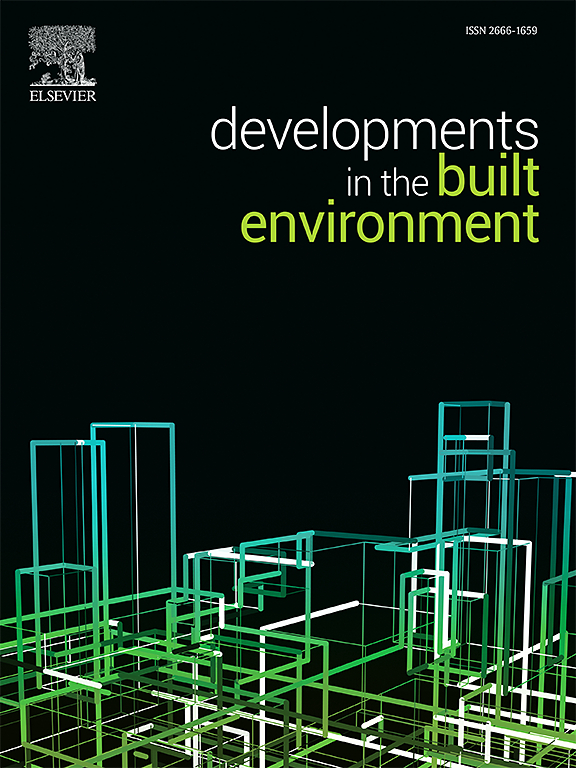Ultrasonic tomography with deep learning for detecting embedded components and internal damage of concrete structures
IF 8.2
2区 工程技术
Q1 CONSTRUCTION & BUILDING TECHNOLOGY
引用次数: 0
Abstract
Ultrasonic tomography is a powerful nondestructive technique for evaluating internal defects in concrete structures. This study presents a deep learning–enhanced approach utilizing a nanoscale object detection model to automate the localization and quantification of internal defects and embedded structural components, including reinforcement bars and ducts. Controlled concrete samples containing artificial defects of varying shapes and depths, along with embedded rebars and ducts, were designed. Ultrasonic signals were collected using a MIRA A1040 tomograph and reconstructed into 3D volumes via Synthetic Aperture Focusing Technique (SAFT). These volumes were converted into 2D slices and segmented using Chan-Vese segmentation and morphological post-processing. A partial histogram matching procedure unified color scales across segmented slices, minimizing color-related biases before model training. Segmentation-assisted labeling provided robust ground truth annotations, resulting in 7220 labeled images. The trained AI model accurately detected delaminations, rebars, and ducts (both grouted and ungrouted), achieving a mean Average Precision ([email protected]) of 0.73 and an Average Intersection-over-Union (IoU) of 0.80. Testing on real-world bridge data demonstrated the model's generalization to unseen conditions. Key innovations include automated segmentation-based labeling, robust color standardization via histogram matching, and a lightweight deep learning model optimized for real-time deployment on resource-constrained devices. This integrated approach has the potential to reduce manual interpretation and subjective variability, providing an effective, scalable NDT/E solution for rapid assessment and monitoring of concrete infrastructure through advanced ultrasonic imaging combined with standardized, machine learning-based defect detection.
基于深度学习的超声层析成像检测混凝土结构的嵌入构件和内部损伤
超声层析成像是评估混凝土结构内部缺陷的一种有效的无损技术。本研究提出了一种深度学习增强方法,利用纳米级物体检测模型来自动定位和量化内部缺陷和嵌入式结构部件,包括钢筋和管道。设计了包含不同形状和深度的人工缺陷的受控混凝土样品,以及嵌入的钢筋和管道。利用MIRA A1040层析成像仪采集超声信号,通过合成孔径聚焦技术(SAFT)重建成三维体。这些体积被转换成二维切片,并使用Chan-Vese分割和形态学后处理进行分割。一个局部直方图匹配程序统一了分割切片的颜色尺度,在模型训练之前最大限度地减少了颜色相关的偏差。分割辅助标记提供了鲁棒的地面真值注释,产生了7220个标记图像。经过训练的人工智能模型准确地检测了分层、钢筋和管道(包括灌浆和未灌浆),平均平均精度([email protected])为0.73,平均交叉-联合(IoU)为0.80。对真实桥梁数据的测试证明了该模型对未知条件的泛化。关键的创新包括基于自动分段的标签,通过直方图匹配的鲁棒颜色标准化,以及针对资源受限设备上的实时部署优化的轻量级深度学习模型。这种综合方法有可能减少人工解释和主观可变性,通过先进的超声成像结合标准化的机器学习缺陷检测,为混凝土基础设施的快速评估和监测提供有效的、可扩展的无损检测/检测解决方案。
本文章由计算机程序翻译,如有差异,请以英文原文为准。
求助全文
约1分钟内获得全文
求助全文
来源期刊

Developments in the Built Environment
Multiple-
CiteScore
7.40
自引率
1.20%
发文量
31
审稿时长
22 days
期刊介绍:
Developments in the Built Environment (DIBE) is a recently established peer-reviewed gold open access journal, ensuring that all accepted articles are permanently and freely accessible. Focused on civil engineering and the built environment, DIBE publishes original papers and short communications. Encompassing topics such as construction materials and building sustainability, the journal adopts a holistic approach with the aim of benefiting the community.
 求助内容:
求助内容: 应助结果提醒方式:
应助结果提醒方式:


